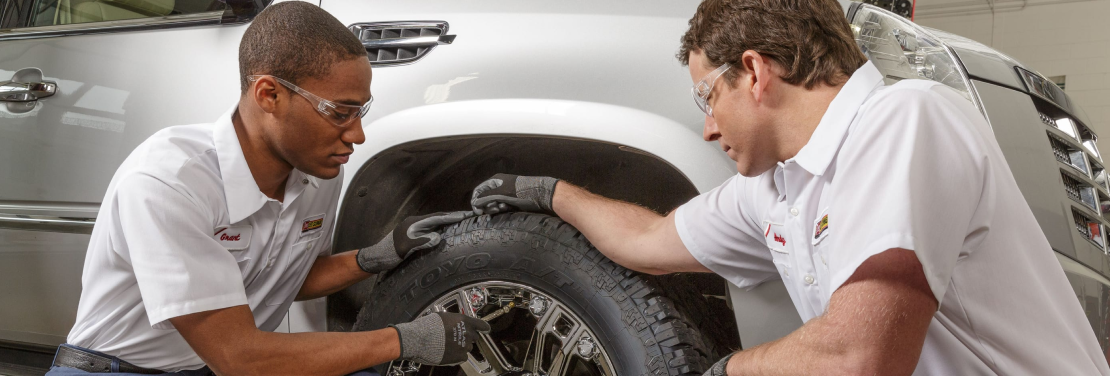Costs Tires Morris IL: Top Quality Products for All Makes and Versions
Costs Tires Morris IL: Top Quality Products for All Makes and Versions
Blog Article
Tire Solution: The Impact of Climate Problems
When it comes to guaranteeing optimal efficiency and safety on the roadway, understanding the effect of weather condition problems on tire solution is critical. In this conversation, we will certainly discover the detailed partnership between weather condition conditions and tire solution, dropping light on the relevance of weather-specific tire upkeep practices and considerations.
Warm and Tire Performance
When exposed to heats, tires experience adjustments in efficiency that can considerably affect car safety and handling. The warmth produced from extended driving or heat problems causes the tire rubber to soften, resulting in lowered step life and enhanced wear. As the rubber comes to be softer, the tire's hold when driving reduces, affecting braking distances and general grip. In extreme instances, too much heat can also create tire blowouts, positioning a severe safety and security risk to the vehicle and its occupants.
In addition, high temperature levels can increase the procedure of tire aging, causing the rubber to weaken extra rapidly. This can result in splits, bulges, and other forms of damages that jeopardize the architectural integrity of the tire. To minimize the results of warm on tire efficiency, chauffeurs ought to on a regular basis examine their tire stress, turn tires to make certain even put on, and inspect for any signs of damage. Additionally, making use of tires specifically designed to hold up against heats can assist keep optimal performance and safety when driving.
Cold Weather Condition Results
Winter conditions can have a significant effect on tire efficiency and safety and security. As temperature levels drop, tire rubber can solidify, causing decreased traction on icy or snow-covered roadways. In cool weather condition, tires might additionally shed atmospheric pressure a lot more rapidly, which can affect handling and fuel effectiveness. Furthermore, cold temperature levels can cause tire sidewalls to tense, raising the risk of damage from gaps or other road dangers.
To minimize the impacts of chilly weather condition on tires, it is crucial to consistently inspect tire stress and inflate them to the supplier's recommended levels. Making use of winter season or all-season tires made for chilly climate problems can likewise boost traction and hold on icy or snowy roads - mopar tire service specials. Correct tire maintenance, consisting of normal evaluations for wear and damages, ends up being a lot more critical during cooler months to make sure ideal efficiency and safety
Rainy Issues Influence
During stormy conditions, tire performance and safety and security can be considerably affected by the wet road surface areas and reduced exposure. The step pattern of tires plays an essential duty in preserving traction on damp roads. Tires with worn-out footsteps are extra prone to hydroplaning, where a layer of water develops in between the tire and the roadway surface, causing loss of grip. To combat this, vehicle drivers should routinely evaluate their tires for adequate walk deepness and think about purchasing tires specifically designed for damp conditions.

Snow and Tire Safety
Snow-covered roadways posture special difficulties for motorists, highlighting the significance of proper tire option and upkeep. When driving in snowy conditions, having the ideal tires can make a substantial difference in safety and efficiency. Winter season tires are designed with unique rubber substances and tread patterns to give far better grip on snow and ice compared to all-season tires. The much deeper footsteps and sipes of wintertime tires aid grip the road better, lowering the risk of gliding and slipping.
In addition to making use of winter months tires, it is critical to guarantee they are correctly inflated. Winter can create tire stress to drop, impacting grip and handling (tire shop morris). Regularly inspecting and preserving the right tire stress is crucial for ideal performance in snowy problems

Weather-Related Tire Maintenance
Weather-related tire maintenance encompasses a range of techniques intended at making certain optimum tire function and long life in different climate situations. One essential facet of weather-related tire maintenance is tire stress policy. Inspecting tire walk frequently and changing tires when walk wear gets to a certain deepness is essential for preserving grip and security in unfavorable weather condition.
Conclusion
In verdict, weather condition problems have a substantial impact on tire performance and safety. From heat affecting tire pressure and use to winter reducing grip, it is important to take into consideration the weather when keeping and utilizing tires. Rainy click here now conditions can lower hold and cause hydroplaning, while snow can enhance the risk of crashes if tires are not effectively geared up. Weather-related tire maintenance is crucial in ensuring optimum performance and safety when traveling.
In this discussion, we will check out the intricate partnership between weather conditions and tire solution, shedding light on the significance of weather-specific tire upkeep techniques and considerations.

Report this page